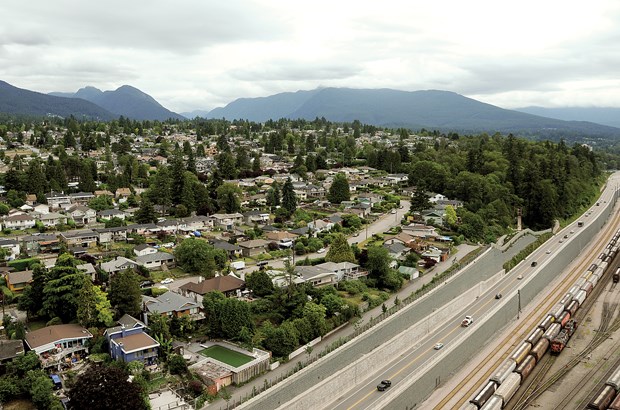Moodyville is changing too much for some and not enough for others – but it’s changing.
In a split vote on May 30, City of North Vancouver council gave final approval to a rezoning that will quadruple the waterfront neighbourhood’s population and replace the collection of Second World War-era bungalows with 1,890 wood-frame townhouses.
Despite supporting the project in a previous vote, Coun. Don Bell expressed disappointment developers were following the exact specifications of the current neighbourhood.
“What we’re creating was not what I’d hoped,” he said.
The development employs a “fairly unimaginative” grid pattern that “simply takes existing streets … and replaces the homes with stacked townhouses,” Bell said.
That replacement will greatly benefit the city, according to Coun. Craig Keating.
Not only will the rezoning help assuage the dearth of ground-oriented townhouses across Metro Vancouver, but the outgoing bungalows are selling for between $1.2 and $1.6 million.
“If that’s the kind of affordability that people want to preserve, I say, have at ’er,” he said.
Coun. Pam Bookham disagreed.
“The loss of affordability in this area is a tremendous loss in this community,” she said, adding the city does not yet have the transportation to handle 3,000 extra residents.
“Once the developers got wind of the proposed changes, it became a free-for-all.”
Bookham and Coun. Rod Clark criticized the rezoning for failing to find a more sensitive interface between industrial land on the port and the nearby residences.
The chugging of grain elevators and other noise from the port has awakened residents on 11th Street and Ridgeway Avenue, according to Clark, himself a Moodyville resident.
“You can imagine what it’s like on First, Second or Third,” he said.
Everyone planning to move into a Moodyville townhouse or apartment should know exactly what they’re buying into, noted Coun. Holly Back.
“If they’re going to buy into it and then complain about the port, they don’t make any sense, they shouldn’t have bought in,” she said. “It’s kind of like the nightclub. I buy the apartment, then I complain the nightclub’s there.”
While the grid will be static, the new neighbourhood should be greener and better connected to biking and hiking trails, said Coun. Linda Buchanan.
Having previously described the new neighbourhood as a look at the future, Mussatto reminded council how the rezoning began.
“A large majority of people in the Moodyville area were the ones that came to us as a council and asked for this rezoning.”
The city is set to take in $30.8 million through density bonus contributions and development cost charges. Approximately one-third of that money is earmarked for utility upgrades and neighbourhood features in Moodyville, but the rest could go toward Harry Jerome Recreation Centre or other city projects, according to a staff report.
During the discussion, Keating teased a future motion which would make rebuilding a large home a little more arduous.
Keating suggested rebuilding a 5,000-square-foot home should require a public hearing. Conversely, homeowners looking to build two single-family homes on a subdivided lot could be readily awarded building permits.



